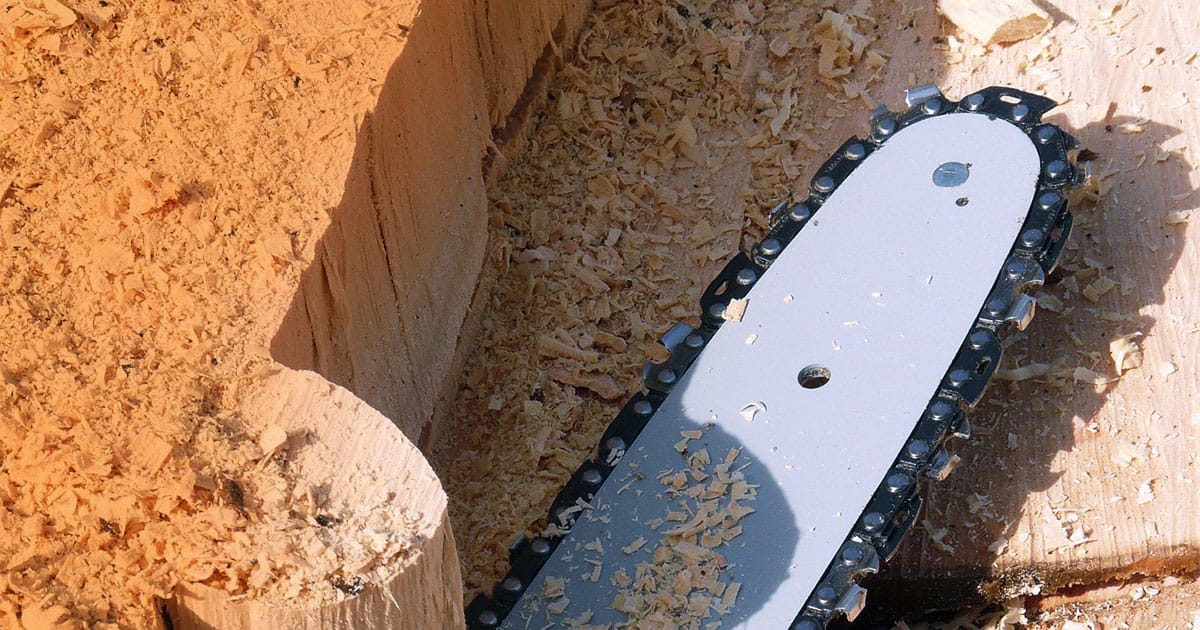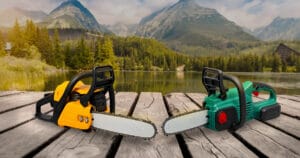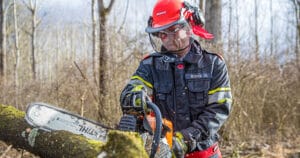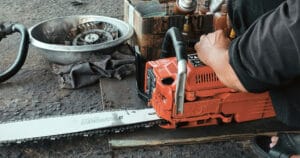A properly tightened chainsaw chain is essential for safe and efficient cutting. If the chain is too loose, it can derail, causing accidents and damaging the saw. On the other hand, an overly tight chain increases wear on the bar and motor, reducing the lifespan of your chainsaw.
Learning how to tighten chainsaw chain correctly ensures smooth performance, precise cuts, and longer equipment life. In this guide, we’ll walk you through the step-by-step process to adjust your chainsaw chain properly, helping you avoid common mistakes.
Whether you’re a beginner or an experienced user, regular chain maintenance is key to safety and efficiency. Let’s get started!
Key Takeaways
- Always check and tighten your chainsaw chain to stay safe.
- Use proper tools, like a scrench, and wear safety gear.
- Keep your chainsaw oiled and stored well to last longer.
Table of Contents
Why Proper Chain Tension is Crucial
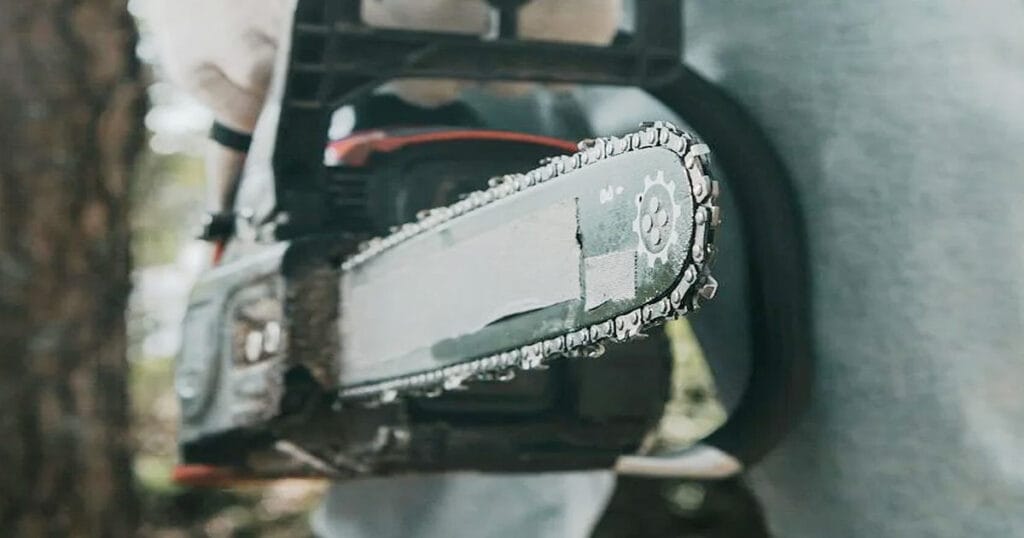
Proper chain tension is crucial for both safety and efficiency when using a chainsaw. If the chainsaw chain is too loose, it can derail from the guide bar, causing serious safety hazards such as kickbacks or sudden jerks during operation. On the other hand, an overly tight chain can cause excessive friction, leading to overheating, wear on the chain and bar, and even potential engine damage.
Safety risks of improper chain tension
Operating a chainsaw with improper chain tension can lead to serious safety hazards. A loose chain increases the risk of kickback, where the saw jerks violently upward. This sudden movement can cause you to lose control, putting you and others nearby in danger. Additionally, a loose chain may derail from the guide bar, potentially causing injuries. On the other hand, an overly tight chain can bind within the bar groove. This binding may result in unexpected stalling, making the chainsaw harder to control and increasing the likelihood of accidents. Ensuring the correct chain tension minimizes these risks and keeps you safer while working.
Effects on chainsaw performance and durability
Improper chain tension doesn’t just compromise safety—it also affects your chainsaw’s performance and lifespan. A chain that is too tight creates excessive friction, leading to faster wear on both the chain and the guide bar. This wear reduces the efficiency of your chainsaw and may require costly replacements. Conversely, a loose chain can slip off the guide bar, interrupting your work and causing additional wear. Regularly adjusting the chain ensures smoother operation, enhances cutting precision, and prevents premature damage. A properly tensioned chain allows your chainsaw to perform at its best, cutting efficiently and reliably.
Common reasons for chain loosening
Chainsaw chains naturally loosen over time due to several factors. The heat generated during operation causes the metal to expand, leading to slack in the chain. Regular use also stretches the chain, especially if it’s not properly maintained. A loose chain may slip off the sprockets, causing the machine to stop working and potentially damaging the chain. This instability can lead to wobbling and vibrations, which increase wear on other components. Poor power transfer from a loose chain forces the machine to work harder, reducing its reliability. Regular inspections and adjustments help you address these issues before they escalate.
How to Tighten Chainsaw Chain
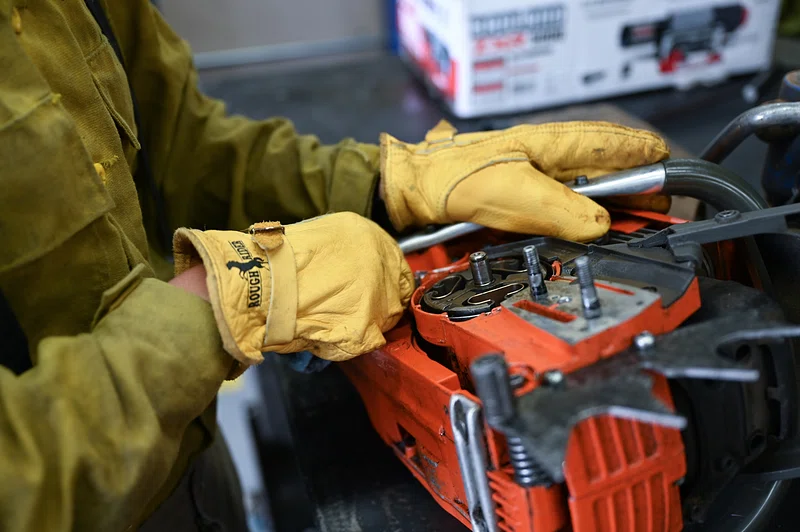
Tools required for tightening
To tighten a chainsaw chain, you need a few essential tools. These tools ensure the process is efficient and safe:
- Scrench: A combination of a wrench and screwdriver, used to loosen bolts and adjust the tensioning pin.
- Screwdriver: Helps turn the tensioning screw for precise adjustments.
- Work gloves: Protect your hands from sharp chain edges.
- Safety glasses: Shield your eyes from debris during the process.
Having these tools ready simplifies the task and ensures you can adjust the chain properly.
Preparing the chainsaw for adjustment
Before you begin, follow these steps to prepare your chainsaw:
- Turn off the chainsaw and unplug it if it’s electric.
- Wear safety gear, including gloves and glasses.
- Loosen the bar nuts slightly to allow movement.
- Locate the tensioning screw near the guide bar.
- Pull the chain gently to check its current tension.
- Apply lubrication to the chain after adjustment to ensure smooth operation.
Proper preparation prevents accidents and makes the adjustment process smoother.
Adjusting the chain with a side tensioner
If your chainsaw has a side tensioner, follow these steps:
- Release the chain brake.
- Loosen the bolts securing the guide bar.
- Use the scrench to turn the tensioning screw clockwise to tighten or counterclockwise to loosen.
- Hold the guide bar’s nose upward while adjusting.
- Check the chain’s snugness by pulling it along the guide bar.
- Perform a “snap” test by pulling the chain slightly and releasing it. It should snap back into place.
This method ensures the chain fits snugly without being overly tight.
Adjusting the chain with a front tensioner
For chainsaws with a front tensioner:
- Loosen the bar nuts slightly.
- Turn the front tensioning screw clockwise to tighten the chain.
- Pull the chain along the guide bar to distribute tension evenly.
- Retighten the bar nuts once the chain is properly adjusted.
This process is straightforward and ensures even tension across the chain.
Using a quick-adjust tensioner
Some chainsaws feature a quick-adjust tensioner for convenience. To use it:
- Release the chain brake.
- Rotate the quick-adjust knob to tighten or loosen the chain.
- Check the chain’s tension by pulling it gently.
Quick-adjust tensioners save time and eliminate the need for additional tools.
Checking the chain tension
After the adjustment, always verify the chain tension. A properly tensioned chain should fit snugly against the guide bar but still move freely. Pull the chain away from the guide bar; it should lift about 1/4 inch without sagging. If it’s too tight or loose, readjust using the tensioning screw.
Tip: Retighten the bar nuts after checking the tension to secure the guide bar in place.
Safety precautions during the process
Safety is crucial when you tighten a chainsaw chain. Follow these precautions:
- Turn off the chainsaw and wait for it to cool.
- Engage the chain brake before starting.
- Wear gloves and safety glasses to protect yourself.
- Avoid over-tightening, as it can cause friction and engine stalling.
- Check for signs of wear on the chain and guide bar.
By prioritizing safety, you reduce the risk of accidents and ensure your chainsaw operates efficiently.
Maintenance Tips for Chain Tension
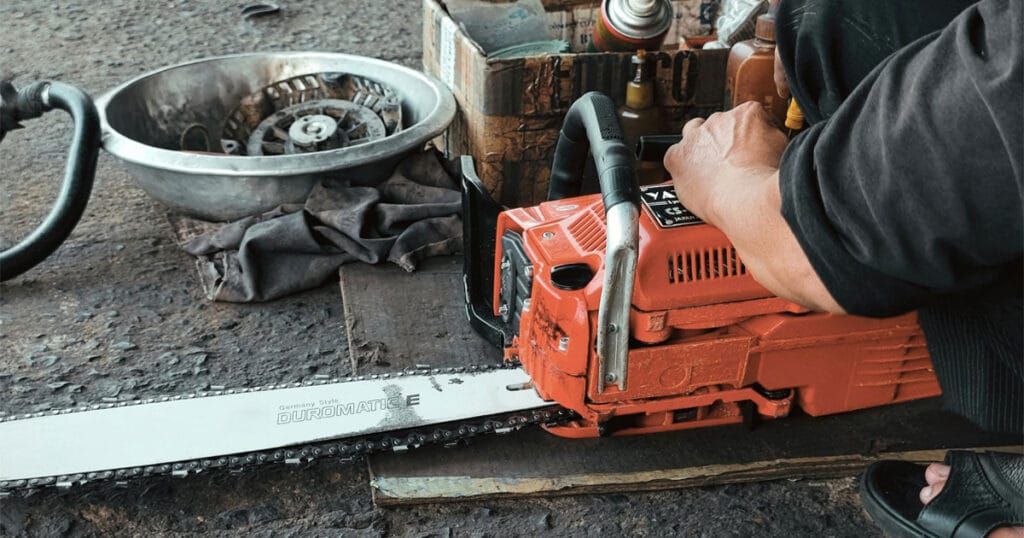
Regular inspection and cleaning
Regular inspection and cleaning play a vital role in maintaining proper chain tension. Dirt and debris can accumulate in the chainsaw’s internal areas, affecting its performance and causing the chain to loosen over time. To keep your chainsaw in top condition:
- Clean the internal components regularly to remove dirt and debris.
- Lubricate moving parts to reduce friction and prevent wear.
- Ensure smooth operation to avoid heat buildup, which can weaken the chain and guide bar.
By incorporating these practices into your routine, you can prevent unnecessary wear and maintain the correct tension for longer periods.
Proper lubrication practices
Lubrication is essential for the smooth operation of your chainsaw. It minimizes friction between the chain and guide bar, reducing wear and helping to maintain optimal tension settings. Proper lubrication also prevents overheating, which can cause the chain to expand and loosen. Always use high-quality bar and chain oil to ensure the best results. Regularly check the oil reservoir and refill it as needed. This simple step not only extends the life of your chainsaw but also ensures it operates efficiently every time you use it.
Storing the chainsaw to prevent damage
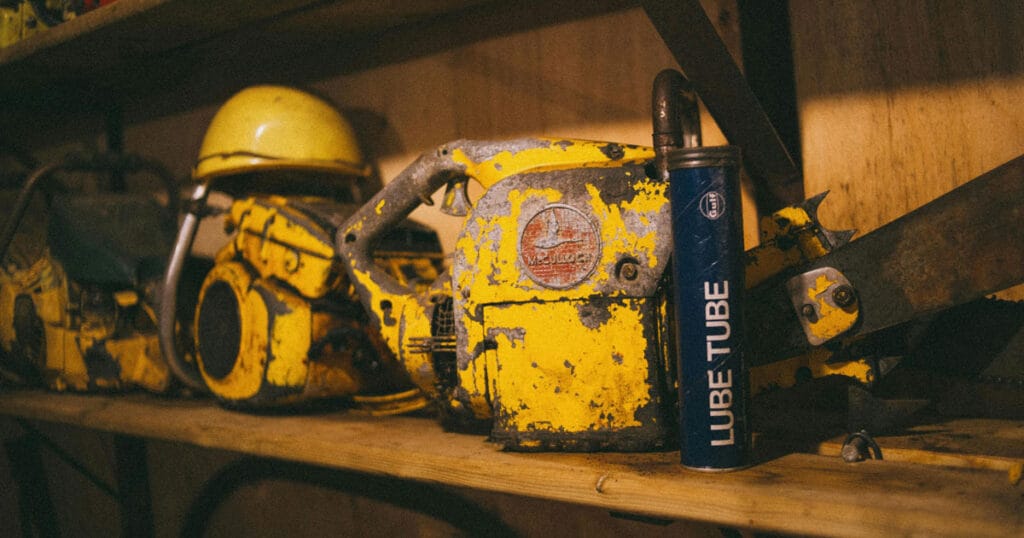
Proper storage is crucial for preventing chain damage and maintaining tension. Follow these best practices to protect your chainsaw:
- Store it in a dry, cool place away from direct sunlight and moisture to prevent corrosion.
- Use a dedicated storage rack or shelf to keep it elevated and free from dirt.
- Cover the chainsaw with a case or protective cover, ensuring it is completely dry before storage.
- Periodically inspect the storage area for moisture or pests that could harm the chainsaw.
Additionally, check the chain, guide bar, and sprocket for wear before storing. Replace any damaged parts to ensure your chainsaw is ready for use when needed. Proper storage not only helps maintain chain tension but also extends the overall lifespan of your equipment.
Final Verdict
Knowing how to tighten a chainsaw chain is crucial for safe and efficient cutting. A properly tensioned chain prevents accidents, reduces wear on your chainsaw, and ensures smooth performance. Always check the chain tension before each use and adjust it as needed to maintain optimal cutting conditions.
By following the simple step-by-step process outlined in this guide, you can keep your chainsaw in top shape and avoid common mistakes like over-tightening or leaving the chain too loose. Regular maintenance will also extend the lifespan of your tool.
A poorly maintained chainsaw becomes harder to control, increasing accident risks. Keeping it in top condition ensures safer and more efficient operation.
Always prioritize safety by wearing protective gear, avoiding tip contact, and cutting larger logs in stages. These practices help you work confidently and prevent injuries.
FAQ
How often should you check the chain tension?
You should inspect the chain tension before every use. Regular checks prevent accidents and ensure your chainsaw operates efficiently.
Can you tighten the chain while the chainsaw is hot?
No, always let the chainsaw cool first. Heat causes the chain to expand, leading to inaccurate adjustments.
What happens if the chain is too tight?
A chain that is too tight increases friction, wears out components faster, and may cause the chainsaw to stall during operation.
Tip: Always follow the manufacturer’s guidelines for proper chain tension to avoid damage and ensure safety.

